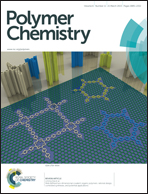Exploring the benefits of β-allyl sulfones for more homogeneous dimethacrylate photopolymer networks†
Abstract
β-Allyl sulfones are well known to act as addition fragmentation chain transfer (AFCT) reagents in radical polymerization of monofunctional monomers, thus giving good control over the molecular weight of the formed polymer. Within this work, we investigated the effect of a difunctional β-allyl sulfone (DAS) as a potent AFCT reagent for dimethacrylate photopolymer networks. Similar to thiol-based chain transfer agents, β-allyl sulfones are expected to change the mode of polymerization from a purely radical chain growth mechanism towards a mixed chain growth/step growth-like polymerization process. Resultant materials should have reduced shrinkage stress, increased conversion, and greater toughness. The studied formulations with added chain transfer reagent were analyzed by photocuring and measuring characteristics such as time until gelation, conversion at the gel point, overall conversion and shrinkage stress. The mechanical properties, such as dynamic modulus, hardness and impact resistance were determined from the resulting photopolymer networks. The investigated β-allyl sulfones provide significant advantages over dithiols as chain transfer reagents. Most importantly, β-allyl sulfones do not have a significant odor or do not cause storage stability problems common to thiol–ene formulations. In addition, the β-allyl sulfones more homogeneously regulate a radical methacrylate polymerization. This paves the way to materials with reduced shrinkage stress, sharpened glass transition, and good impact resistance. In addition, hardness and storage or elastic modulus of the materials are significantly higher compared to the dithiol-based materials.


 Please wait while we load your content...
Please wait while we load your content...